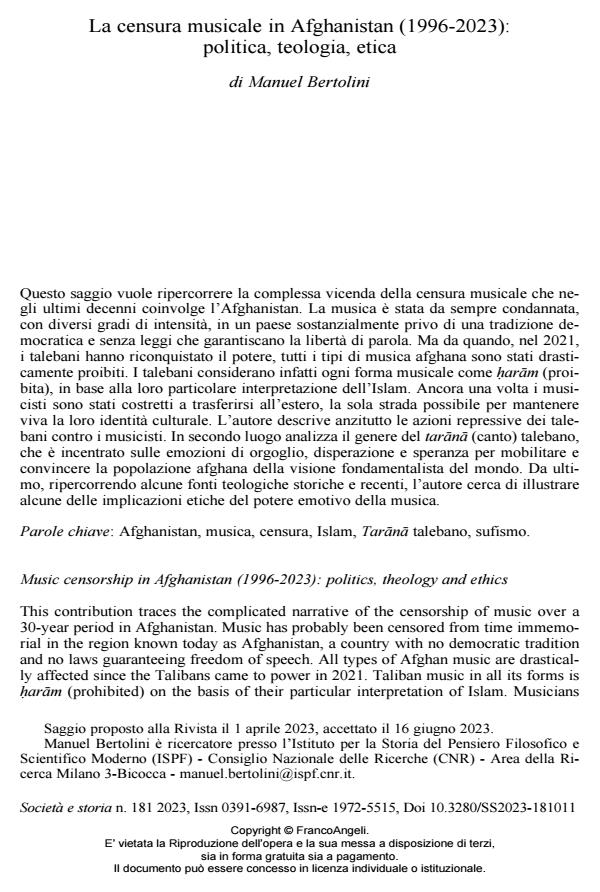La censura musicale in Afghanistan (1996-2023): politica, teologia, etica
Titolo Rivista SOCIETÀ E STORIA
Autori/Curatori Manuel Bertolini
Anno di pubblicazione 2023 Fascicolo 2023/181
Lingua Italiano Numero pagine 24 P. 617-640 Dimensione file 229 KB
DOI 10.3280/SS2023-181011
Il DOI è il codice a barre della proprietà intellettuale: per saperne di più
clicca qui
Qui sotto puoi vedere in anteprima la prima pagina di questo articolo.
Se questo articolo ti interessa, lo puoi acquistare (e scaricare in formato pdf) seguendo le facili indicazioni per acquistare il download credit. Acquista Download Credits per scaricare questo Articolo in formato PDF

FrancoAngeli è membro della Publishers International Linking Association, Inc (PILA)associazione indipendente e non profit per facilitare (attraverso i servizi tecnologici implementati da CrossRef.org) l’accesso degli studiosi ai contenuti digitali nelle pubblicazioni professionali e scientifiche
Questo saggio vuole ripercorrere la complessa vicenda della censura musicale che negli ultimi decenni coinvolge l’Afghanistan. La musica è stata da sempre condannata, con diversi gradi di intensità, in un paese sostanzialmente privo di una tradizione democratica e senza leggi che garantiscano la libertà di parola. Ma da quando, nel 2021, i talebani hanno riconquistato il potere, tutti i tipi di musica afghana sono stati drasticamente proibiti. I talebani considerano infatti ogni forma musicale come ?aram (proibita), in base alla loro particolare interpretazione dell’Islam. Ancora una volta i musicisti sono stati costretti a trasferirsi all’estero, la sola strada possibile per mantenere viva la loro identità culturale. L’autore descrive anzitutto le azioni repressive dei talebani contro i musicisti. In secondo luogo analizza il genere del tarana (canto) talebano, che è incentrato sulle emozioni di orgoglio, disperazione e speranza per mobilitare e convincere la popolazione afghana della visione fondamentalista del mondo. Da ultimo, ripercorrendo alcune fonti teologiche storiche e recenti, l’autore cerca di illustrare alcune delle implicazioni etiche del potere emotivo della musica.�
Parole chiave:Afghanistan, musica, censura, Islam, Tarānā talebano, sufismo.
Manuel Bertolini, La censura musicale in Afghanistan (1996-2023): politica, teologia, etica in "SOCIETÀ E STORIA " 181/2023, pp 617-640, DOI: 10.3280/SS2023-181011